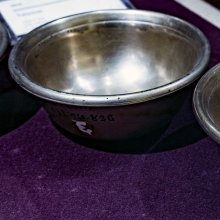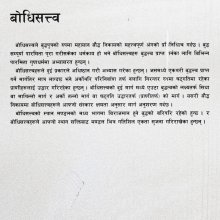Shidha, Śidhā: 4 definitions
Introduction:
Shidha means something in Marathi, Hindi, biology. If you want to know the exact meaning, history, etymology or English translation of this term then check out the descriptions on this page. Add your comment or reference to a book if you want to contribute to this summary article.
Images (photo gallery)
Biology (plants and animals)
Source: Google Books: CRC World Dictionary (Regional names)Sidha in India is the name of a plant defined with Lagerstroemia parviflora in various botanical sources. This page contains potential references in Ayurveda, modern medicine, and other folk traditions or local practices.
Example references for further research on medicinal uses or toxicity (see latin names for full list):
· Ceiba (1975)
If you are looking for specific details regarding Sidha, for example diet and recipes, health benefits, chemical composition, side effects, extract dosage, pregnancy safety, have a look at these references.

This sections includes definitions from the five kingdoms of living things: Animals, Plants, Fungi, Protists and Monera. It will include both the official binomial nomenclature (scientific names usually in Latin) as well as regional spellings and variants.
Languages of India and abroad
Marathi-English dictionary
Source: DDSA: The Molesworth Marathi and English Dictionaryśidhā (शिधा).—m (siddha S through H) Undressed rice or corn and fuel to dress it; as taken on a journey, as sent to another's house, as given to a mendicant, guest, dunning peon &c.: also undressed rice or corn more generally. Note. śidhā is derived from siddha as well as śidōrī, a word resembling it in form and sound, but opposing it in sense; but whilst śidōrī draws its applications from the sense (of siddha) Prepared or made ready, śidhā is formed from the sense Ready at hand, ready in the cornbin or the house.
--- OR ---
sidhā (सिधा).—See these words under śi, although, as thus spelled, they are spelled as rightly.
Source: DDSA: The Aryabhusan school dictionary, Marathi-Englishśidhā (शिधा).—m Undressed rice and fuel to dress it.
Marathi is an Indo-European language having over 70 million native speakers people in (predominantly) Maharashtra India. Marathi, like many other Indo-Aryan languages, evolved from early forms of Prakrit, which itself is a subset of Sanskrit, one of the most ancient languages of the world.
Hindi dictionary
Source: DDSA: A practical Hindi-English dictionary1) Sīdha (सीध) [Also spelled sidh]:—(nf) alignment; straightness; —[bāṃdhanā] to align; to take an aim; to dig marks symbolising commencement of a construction work; —[meṃ] in a straight line, aligned; —[lenā] to make an alignment to take an aim.
2) Sīdhā (सीधा):—(a and adv) straight; simple; right; erect, upright; direct; gentle; naive; good; forthrightly; through; (nm) victuals earmarked for a Brahman as alms; ~[pana] simplicity; straightness; uprightness; gentleness; naivete; —[sādā/sādhā] simple, innocent; gentle; naive; good; docile; —[hātha] right hand; —[ānā] to come straight, to come without a halt or detour; —[karanā] to put straight; to knock out one’s haughtiness/conceit, to fix in one’s proper place; to align; —[tīra-sā] direct; as fast and straight as an arrow; —[honā] to be put straight; to have one’s haugatiness/conceit knocked out; to be fixed in one’s proper place, to be aligned.
...
See also (Relevant definitions)
Starts with: Shidhapani, Shitakiranan, Shitamantali, Sitalam, Sitam.
Ends with: Naishidha, Nishidha.
Full-text: Sidha-kisimale, Sidhai, Siddhanna, Sidh, Sidhi, Ullu, Pamsa, Atarota, Muktagiri, Shidori, Ulta, Nasib, Nashiba, Pasha, Apana, Naka, Naak.
Relevant text
Search found 10 books and stories containing Shidha, Śidhā, Sidha, Sidhā, Sīdha, Sīdhā, Sidhaa; (plurals include: Shidhas, Śidhās, Sidhas, Sidhās, Sīdhas, Sīdhās, Sidhaas). You can also click to the full overview containing English textual excerpts. Below are direct links for the most relevant articles:
Mahabharata (English) (by Kisari Mohan Ganguli)
Section CLXII < [Tirtha-yatra Parva]
The Devi Bhagavata Purana (by Swami Vijñanananda)
The Gautami Mahatmya (by G. P. Bhatt)
Srila Gurudeva (The Supreme Treasure) (by Swami Bhaktivedanta Madhava Maharaja)
Vaiṣṇava-sevā < [Chapter 1.4 - Life in the Maṭha]
Yoga Vasistha [English], Volume 1-4 (by Vihari-Lala Mitra)
Chapter XVIII - Manners of the matrika goddesses < [Book VI - Nirvana prakarana part 1 (nirvana prakarana)]
Related products


